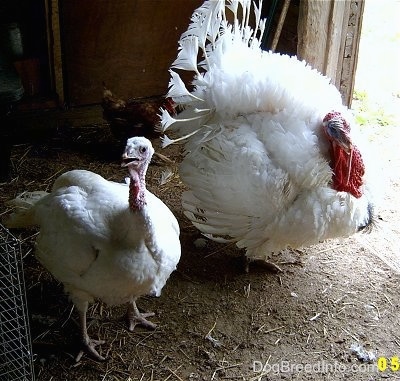So I thought I'd do an entry on one of them, turkeys, just because that's what my brain is saying to me.

These are domestic turkeys. The big one on the right is Wally, and the smaller one on the left is Wendy. They are 10 months old.
(Photo from the Dog Breed Info Center)
- At nightfall, turkeys fly up to the low branches of trees to sleep. But that's usually only wild turkeys that do that. Most domestic turkeys are too fat to fly.
- A female turkey may lay as many as 18 eggs at a time.
- When upset or excited during courtship, the bare skin on the turkey's head and throat may change from its usual gray to white, bright red, or even blue.
- All those weird fleshy things that hang down below the turkey's chin (the wattle) or over the turkey's beak (the snood) are there to attract mates. Those also turn color during courtship.
- Some breeders put a special cloth garment over their turkeys to prevent their feathers from getting damaged while breeding takes place. Those garments are called turkey saddles.
A turkey saddle
(Photo from Feathersite)
- Males not ready to breed, or immature males, are called jakes. Adult males are called gobblers, and females are called hens.
- The number of turkeys raised in the United States in 2005 was down 3% from 2004, to a mere 256 million birds.

Wild turkeys, living on Long Island and monitored by the US Dept of Energy's Brookhaven National Laboratory.
(Photo from Brookhaven Natl Lab)
- Among other things, wild turkeys like to eat corn.
- Wild Turkey whiskey is named for the fact that it was originally distilled in Wild Turkey Hill in Lawrenceburg, Kentucky.
- Originally, in order to be called bourbon, a whiskey had to be distilled in Bourbon County, Kentucky, which used to be as big as 17 present-day counties grouped together, and the whiskey had to be made from a mash of no less than 51% corn. Today, any whiskey made in Kentucky can be called Bourbon.

Another kind of Wild Turkey
(Photo from UK Wines)
Sources
Kidzone, The American Turkey
Feathersite, Turkeys
Wisconsin Department of Natural Resources, Environmental Education for Kids, the Wild Turkey
National Agricultural Statistics Service, Turkeys Raised, Jan 06
Wild Turkey Bourbon, History
Wikipedia, Bourbon County, Kentucky
No comments:
Post a Comment
If you're a spammer, there's no point posting a comment. It will automatically get filtered out or deleted. Comments from real people, however, are always very welcome!